by Steve Rockwell
Lorien Suarez-Kanerva’s New Spiritual Abstraction carries a vital charge that fulfills Bruce Nauman’s claim in the text of his iconic 1967 neon wall sign, The True Artist Helps the World by Revealing Mystic Truths. There is an import to Suarez-Kanerva’s paintings that impels the viewer toward the sublime, the evident dynamism of the artist’s execution rendering its draught irresistible.
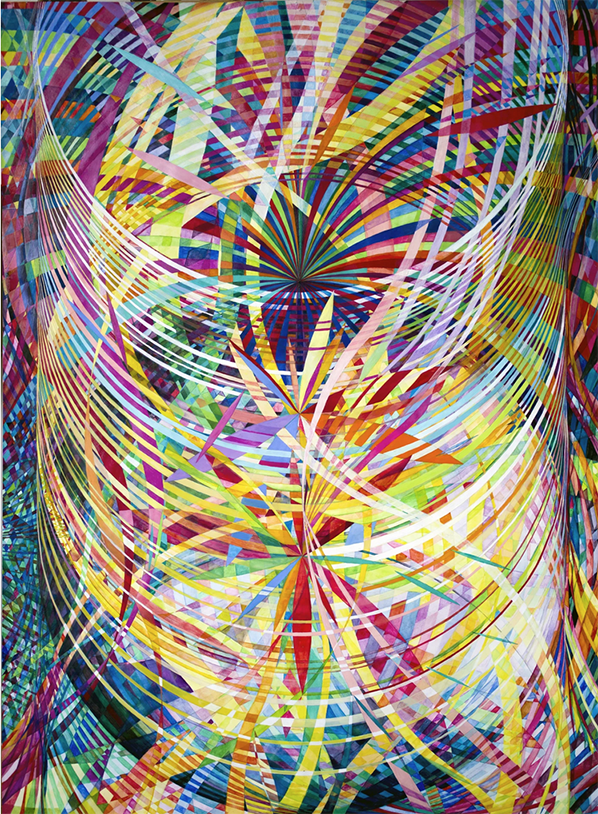
The visual gestalt of Elan Flow 6, and particularly Wheel within a Wheel 50, form whirlpools of meticulously painted slivers that deliver A Descent into the Maelström as described by Edgar Allen Poe in his 1841 short story. While Suarez-Kanerva depicts a wheel within a wheel, Poe’s is a story within a story, both revelatory encounters with nature, altogether beautiful and awesome as creations.
The Old Testament prophet Ezekiel experienced his Wheel within a Wheel as a rupture of the visible heavens, revealing the fiery fabric beneath its skin. He described the appearance and structure of the wheels as sparkling like topaz, all four alike, “Each appeared to be made like a wheel intersecting a wheel. As they moved, they would go in any one of the four directions the creatures faced; the wheels did not change direction as the creatures went.” Not surprisingly, interpreters of our age have imagined alien space craft.
Attempts over the centuries to depict what Ezekiel saw tended to the literal. Modernism, however, has bestowed Suarez-Kanerva the mantle of abstraction, a providential gift to tell her own visual story through her art. The employment of her own brand of the fractal contrasts with the complex mathematical class of geometric shapes. While computers by means of Mandelbrot Sets may generate these forms from virtually anything in our environment from coastlines to mountains, and clouds to hurricanes, each Suarez-Kanerva painting is a unique synthesis of elements directly observed in nature. A fluency in the language of abstraction has made the transcription of her insights in paint authoritative.
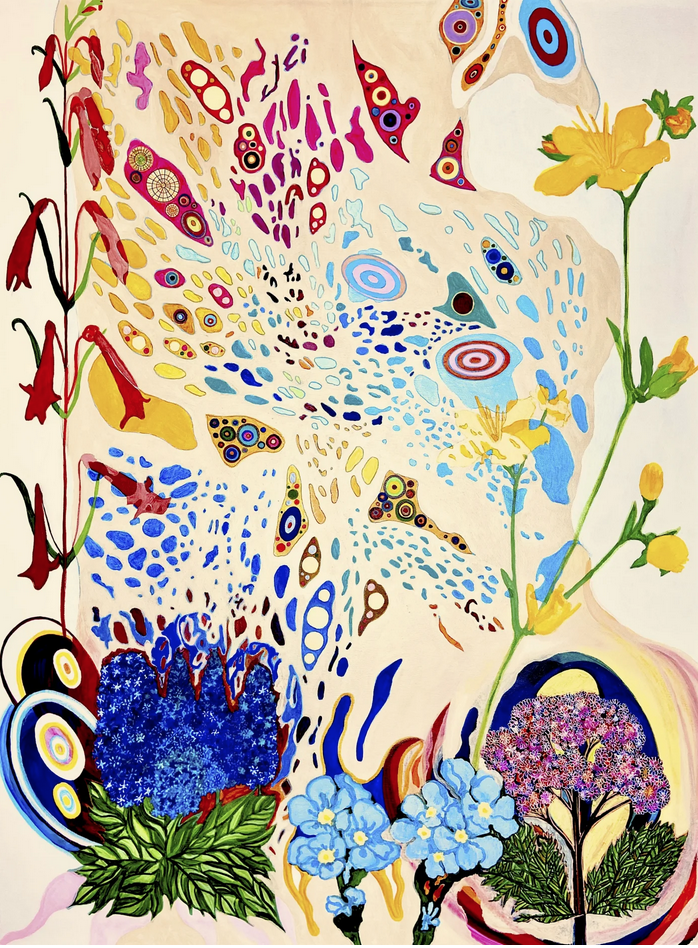
Suarez-Kanerva’s art conforms to a law of geometry that generates a sense of the living from the inorganic. The connection to nature rooted in childhood memories of nature-hikes and world travels had clearly seeded the artist’s vision for creative possibilities. Having grown up in diverse environments such as Oregon and Venezuela further broadened her scope, enabling the inference of broader principles at play in the biosphere. This identification with the “living matrix” has found its medium of expression in the material tools of her craft. The inherent qualities of ink, pencil, pastels, water-colour, gouache and acrylic combined with the properties of paper canvas, and wood, are chemically reactive within the viewer’s sensorium, producing a virtual light show in the rods and cones in the retinal wall of the eye. When channeled through a variety of geometric forms and templates, energy is released. Within the “wheel within a wheel” theme alone, the painterly possibilities presented are virtually infinite.
In Donald Kuspit’s Whitehot Magazine article, The New Abstraction: Lorien Suarez-Kanerva, he observed that the artist has tapped into the sublime by means of a play of opposites, effectively harnessing the tensions between “biosphere and noosphere,” something that Kant had found terrifying and beyond comprehension. Through an active “spiralling” of the universe as a whole, a kind of unity or Omega Point is inferred, arriving at the transcendence that Emerson in his philosophy advanced. Suarez-Kanerva clearly substantiates Nauman’s contention that the work of true artist plays an essential role in the revelation of “mystic truths.”
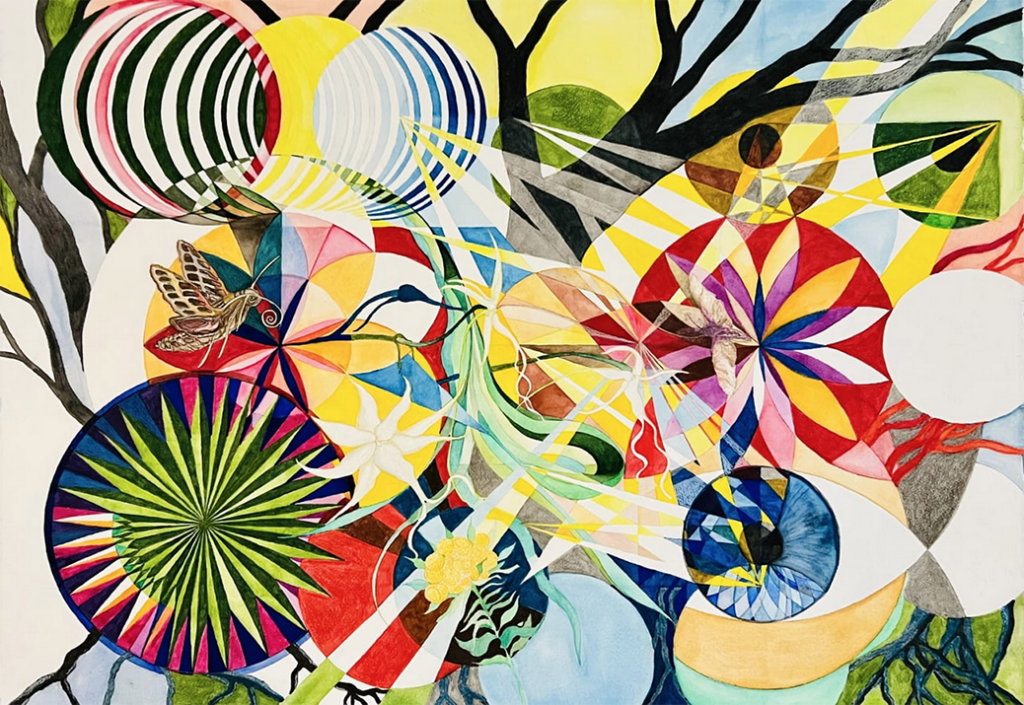
The 2023 water-colour and gouache, Beholder is an integration and refraction of tree, flower and insect as if by laser beam, the 2022 Breath of Life acrylic a dissolution into gentle waft, a dematerialization to airy essence. Each atomized fragment, like DNA, carries its blueprint as seeded potential, sealing the image with the hope for perpetuity. With the Elan Flow series, the germinative release of energy verges on the explosive. Here again is an echo of what Poe described as sublimely beautiful, yet awesome in power as latency.
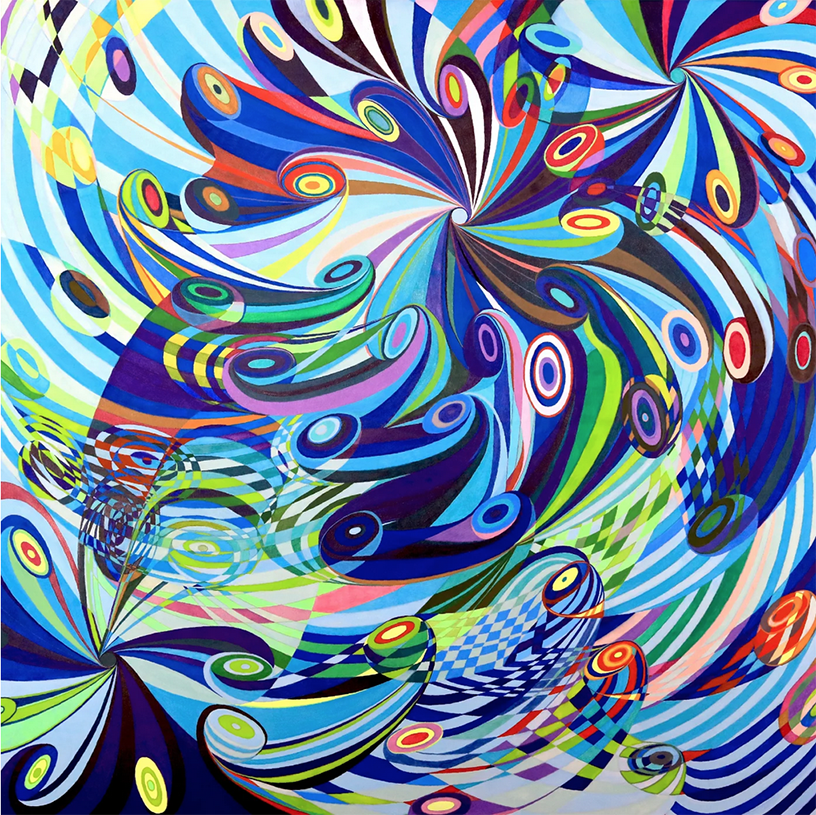
Suarez-Kanerva is a metamodernist by virtue of the vitalist optimism that infuses her art. The artist’s ability to integrate multiple techniques and theories allow for a plumb of the “the structure of feeling.” Works such as Wildflower Fields, (California Native Plants #2) 2023 and Wheel within a Wheel 112, 2017 retain evidence of the hand, the living gesture as affirmation. Within the diversity of Suarez-Kanerva’s “Visionary Geometries” the point of unifying singularity is the circle, a restless orb in perpetual motion, seeding a harvest from one series of works into another. While the recent Wooded Terrain series of raw wood panel works are devoid of this element, the aura of restless vitality remains.
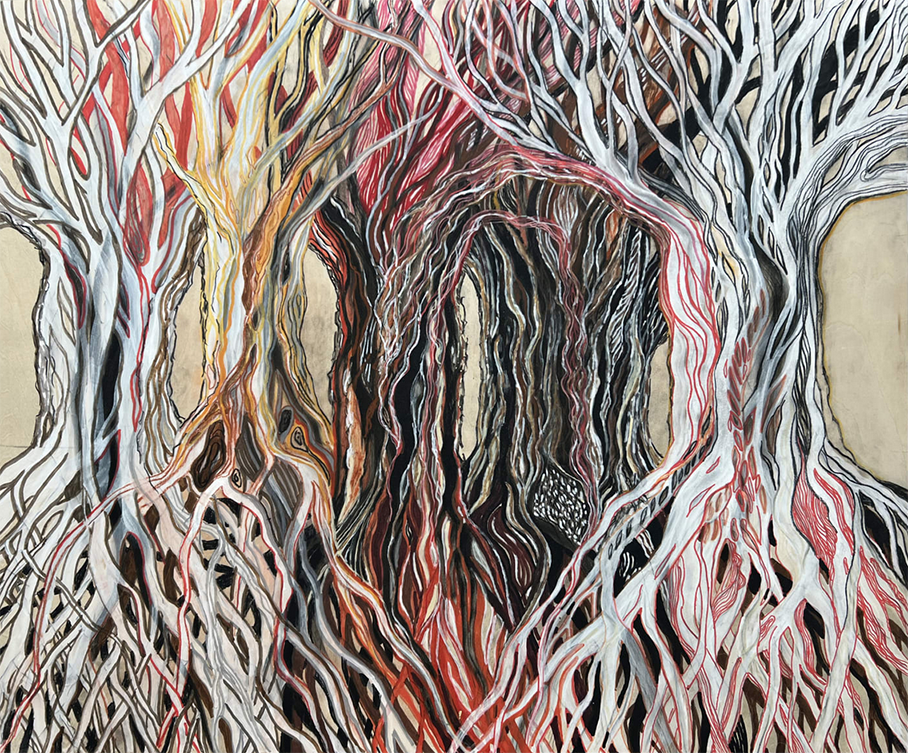
“I build multiple levels and layers of elaborate designs that emerge from an underlying matrix to create a strong sensation of growth, movement and depth.” The artist’s operating principle of constructing her painting in levels and layers is an understatement. More aptly, Suarez-Kanerva engages in a joyous plunder of the corpus of modernism, its roots and the art of the past. Having surveyed the dazzling complexity of her output, this romp through art history has yielded amply productive treasure. The artist possesses the gift of precisely gleaning the element required from an artist. With Joseph Stella it might have been his dense lattice of abstracted forms. A gloss of the Bauhaus zeitgeist combined with the Abstraction-Creation artists of the 1930s has streamed her influences into an apex in harmony with the Orphism of Robert and Sonia Delaunay. As Robert Delaynay elegantly summarized, “Painting by nature is a luminous language.”
Lorien Suarez-Kanerva’s New Spiritual Abstraction Exhibitions:
June 14 – August 30, 2024 at the Mary G. Hardin Center for Cultural Arts in Gadsden, AL
June 13 – October 18, 2025 at the Museum of Arts and Sciences in Macon, GA
January 2026 – April 2026 at the Phillips Museum of Art, Franklin and Marshall College, Lancaster, PA
